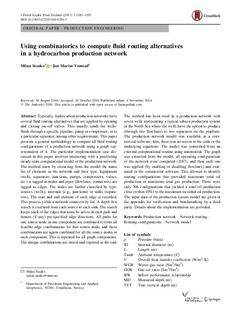| dc.contributor.author | Stanko, Milan | |
| dc.contributor.author | Venstad, Jon Marius | |
| dc.date.accessioned | 2018-04-26T08:20:05Z | |
| dc.date.available | 2018-04-26T08:20:05Z | |
| dc.date.created | 2016-11-05T11:51:56Z | |
| dc.date.issued | 2017 | |
| dc.identifier.citation | Journal of Petroleum Exploration and Production Technology. 2017, 7 (4), 1185-1195. | nb_NO |
| dc.identifier.issn | 2190-0558 | |
| dc.identifier.uri | http://hdl.handle.net/11250/2496061 | |
| dc.description.abstract | Typically, hydrocarbon production networks have several fluid routing alternatives that are applied by opening and closing on–off valves. This usually sends the wells’ fluids through a specific pipeline, pump or compressor, or to a particular separator, among other requirements. This paper presents a general methodology to compute all fluid routing configurations of a production network using a graph representation of it. The particular implementation case discussed in this paper involves interacting with a preexisting steady-state computational model of the production network. The method starts by extracting from the model the name list of elements in the network and their type. Equipment (wells, separators, junctions, pumps, compressors, valves, etc.) is tagged as nodes and pipes (flowlines, connectors) are tagged as edges. The nodes are further classified by type: sources (wells), internals (e.g., junctions) or sinks (separators). The start and end element of each edge is recorded. This process yields a network connectivity list. A depth-first search is executed from each source to each sink. The search keeps track of the edges that must be active in each path and honors (if any) pre-specified edge directions. All paths for one source node in one component are combined to form all feasible edge combinations for that source node, and these combinations are again combined for all the source nodes in each component. This is repeated for all graph components. The unique combinations are stored and reported at the end. The method has been tried in a production network with seven wells representing a typical subsea production system in the North Sea where the wells have the option to produce (through two flowlines) to two separators on the platform. The production network model was available in a commercial software; thus, there was no access to the code or the underlying equations. The model was controlled from an external computational routine using automation. The graph was extracted from the model, all operating configurations of the network were computed (2187), and then each one was applied (by enabling or disabling flowlines) and evaluated in the commercial software. This allowed to identify routing configurations that provided maximum total oil production or maximum total gas production. There were only 306 configurations that yielded a total oil production close (within 10%) to the maximum recorded oil production. The input data of the production system model are given in the appendix for verification and benchmarking by a third party. Details about the implementation are provided. | nb_NO |
| dc.language.iso | eng | nb_NO |
| dc.publisher | SpringerOpen | nb_NO |
| dc.rights | Navngivelse 4.0 Internasjonal | * |
| dc.rights.uri | http://creativecommons.org/licenses/by/4.0/deed.no | * |
| dc.title | Using combinatorics to compute fluid routing alternatives in a hydrocarbon production network | nb_NO |
| dc.type | Journal article | nb_NO |
| dc.type | Peer reviewed | nb_NO |
| dc.description.version | publishedVersion | nb_NO |
| dc.source.pagenumber | 1185-1195 | nb_NO |
| dc.source.volume | 7 | nb_NO |
| dc.source.journal | Journal of Petroleum Exploration and Production Technology | nb_NO |
| dc.source.issue | 4 | nb_NO |
| dc.identifier.doi | 10.1007/s13202-016-0291-1 | |
| dc.identifier.cristin | 1397609 | |
| dc.description.localcode | © The Author(s) 2016. Open Access. This article is distributed under the terms of the Creative Commons Attribution 4.0 International License (http://creativecommons.org/licenses/by/4.0/). | nb_NO |
| cristin.unitcode | 194,64,90,0 | |
| cristin.unitname | Institutt for geovitenskap og petroleum | |
| cristin.ispublished | true | |
| cristin.fulltext | original | |
| cristin.qualitycode | 1 | |

